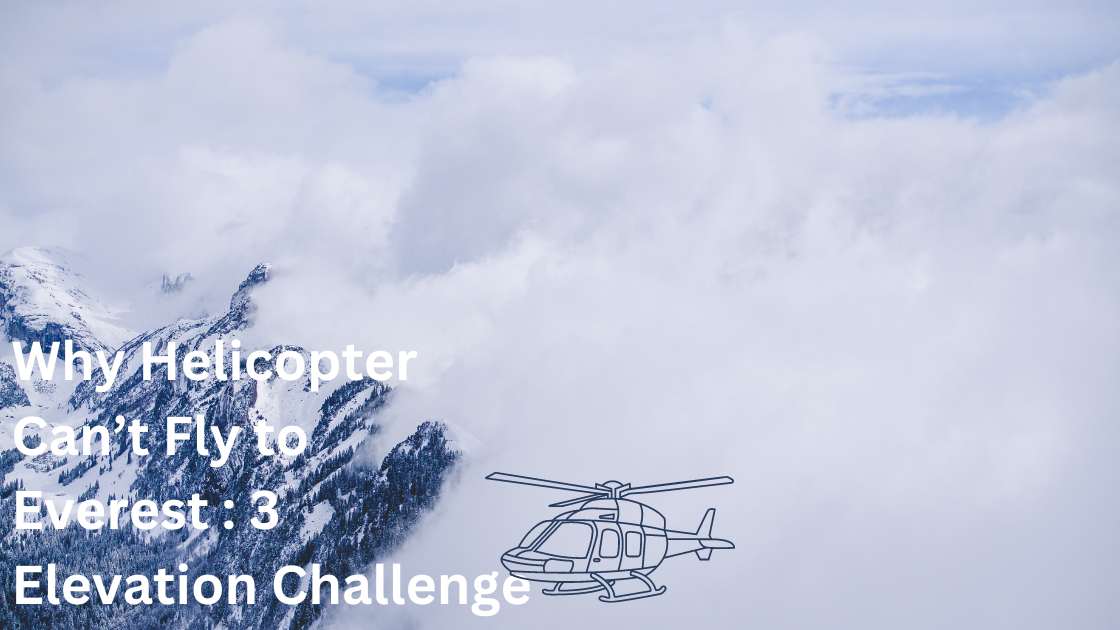
Why Helicopter Can’t Fly to Everest: 3 Elevation Challenge
Nestled in the heart of the awe-inspiring Himalayas, the lofty summit of Everest stands as an irresistible attraction for adventure enthusiasts and thrill-seekers alike. In this exploration, we reveal the mysteries behind why helicopter can’t fly to Everest and the various Everest helicopter limitations that hinder their ascent. While helicopters have become synonymous with the freedom of aerial exploration, an extraordinary challenge persists—these advanced rotorcraft face obstacles when attempting to conquer the towering heights of Everest’s peak. Altitude Restrictions for Helicopters become evident when confronting the towering peak of Everest.
Despite their ability to reach impressive altitudes, helicopters are not designed to navigate the extreme conditions of the “death zone” where oxygen constraints for helicopter flights are critically low. The thin air and harsh weather conditions at such heights present a set of challenges that helicopters, with their current technology, simply cannot overcome. One primary limitation “Why Helicopter Can’t Fly to Everest” is the reduced air density at extreme altitudes. Helicopter flight challenges at high altitudes arise as the air thins, and rotor blades, responsible for generating lift, encounter diminishing returns in lift production.
The challenges extend to the helicopter engine’s performance in thin air, meticulously designed for efficient operation within specific altitude ranges. The struggle to generate the thrust needed for further ascent becomes apparent, making the journey to Everest’s summit an unattainable feat for helicopters. The Everest summit, shrouded in clouds and mystery, remains beyond the reach of helicopters due to the extreme altitude, thin air, and unpredictable weather patterns. These various limitations encapsulate the reasons helicopters cannot reach Everest summit and illuminate why helicopters are unable to fly to Mount Everest.
The Everest Elevation Challenge: Why Helicopter Can’t Fly to Everest
Navigating the breathtaking heights of Everest proves to be an extraordinary challenge for helicopters, reaching a staggering 29,032 feet (8,848 meters) above sea level. The challenge is that these incredible flying machines can reach impressive heights, but they grapple with inherent limitations in helicopter altitudes. The daunting conditions of the “death zone,” where oxygen levels are critically low, present an impossible hurdle for high-altitude helicopter operations. The thin air at these extreme heights, combined with harsh weather conditions, creates a formidable barrier that hinders the fluidity of helicopter flight. Consequently, Everest’s summit becomes an elusive destination, showcasing the inherent challenges faced by helicopters when launching into the unparalleled altitudes of the Himalayas.
Unpredictable Weather Patterns:
The weather in the Everest region, where the highest mountain in the world is located, is well-known for its unpredictable patterns, making it difficult for aerial activities. The weather conditions in this area are famously changeable, with sudden and unpredictable changes in wind speed, visibility, and temperature. Flying in this region is a risky undertaking due to the constantly changing weather conditions. Despite their versatility, helicopters face challenges due to their vulnerability to changing weather conditions.
To prioritize passenger safety, helicopter operators in the Everest region impose restrictions on flying at extreme altitudes. The unpredictable weather in this area, including sudden changes in wind speed, visibility fluctuations, and temperature variations, can pose significant threats to helicopter flights. Therefore, caution must be exercised, and operations should be limited in such challenging weather scenarios. The unpredictable nature of the Everest region’s weather is a critical factor that affects the safety and feasibility of helicopter flights in navigating its towering peaks and deep valleys.
Engine Struggles:
The performance of helicopter engines is adversely affected by the reduced air pressure and lower levels of oxygen in the thinning atmosphere at higher elevations, posing a critical challenge for helicopters undertaking the towering heights of Everest. These rotorcraft are intricately crafted to operate with optimal efficiency within specific altitude ranges, but as they ascend, they encounter a series of obstacles. As helicopters climb toward the peak of Everest, their carefully engineered engines have to contend with the effects of reduced air pressure and oxygen levels.
This unfavorable combination leads to a noticeable decrease in power output. The engine, which is essential for generating the required thrust to move the helicopter forward, encounters significant difficulties in these demanding atmospheric conditions. The compromised efficiency of the engine becomes a determining factor, rendering the aspiration of reaching Everest’s summit an elusive and unachievable accomplishment for helicopters. The thin atmosphere of Everest’s heights presents significant engineering and operational challenges for helicopters attempting to conquer the world’s highest peak, as it disrupts the delicate balance of engine performance within specific altitude parameters.
Technological Limitations:
The technological limitations faced by helicopters in reaching the summit of Everest make the challenge even more difficult. Despite advancements in aviation technology, there is currently no helicopter specifically designed for high-altitude missions to Everest. The existing helicopters, although versatile, do not have the necessary features to overcome the challenges posed by the extreme conditions at such altitudes, including thin air, low temperatures, and unpredictable weather. The current helicopters lack the necessary engine power and aerodynamics to navigate successfully through Everest’s harsh environment.
The extreme conditions of thin air and sub-zero temperatures require advanced engineering beyond what current rotorcraft can provide. Creating a helicopter that can effectively navigate through the harsh conditions surrounding the summit of Everest is a difficult engineering task. It requires improved engine power, aerodynamics designed for thin air, and the ability to withstand unpredictable weather patterns. These challenges call for a significant breakthrough in technological innovation. Until these advancements are made, the existing technological limitations remain a major obstacle, preventing helicopters from reaching the unmatched heights of Everest’s summit.
Helicopter Tours: An Alternative Perspective
By accepting the fact that helicopters can’t land on the summit of Everest, a fascinating alternative perspective arises through helicopter tours. Although reaching the summit is still out of reach, helicopters provide a distinct and exciting viewpoint for discovering the awe-inspiring landscapes that encompass Everest. These helicopter tours offer a thrilling experience, enabling passengers to admire the magnificent beauty of the Himalayas while ensuring their safety. The tours are attractive because they can display the famous peaks, large glaciers, and deep valleys that characterize the Everest region.
Travelers go on a trip that reveals the magnificence of the Himalayas, capturing the true nature of this impressive terrain from the air. The helicopter’s flexibility allows for a panoramic view of the landscape, offering a perspective that is both breathtaking and immersive. For those who love adventure, these tours are a captivating option that provides a glimpse of the Everest adventure without the dangers involved in attempting to reach the summit. It presents a special chance to admire the breathtaking surroundings of Everest, creating unforgettable memories and a profound admiration for the stunning beauty of the Himalayas, all while enjoying the safety and convenience of a helicopter tour.
The Thin Air Dilemma: Why Helicopter Can’t Fly to Everest
The difficulty of reaching the summit of Everest is closely related to thin air effects on helicopter, which is a major obstacle for helicopters attempting to climb to such high altitudes. At extreme elevations, the air becomes much less dense, making it harder for helicopters to generate lift with their rotor blades. As the rotor blades spin through the increasingly thin air at higher altitudes, they experience diminishing returns in terms of lift production.
This inherent limitation becomes a crucial factor that prevents helicopters from achieving the required lift to either hover or continue ascending towards the summit of Everest. The complex dynamics between altitude and air density make it impossible for helicopters to overcome the challenges posed by Everest’s towering heights. The reduction in air density at extreme altitudes hinders the efficiency of rotor blades, making it difficult for them to generate the necessary lift force. Therefore, despite their impressive capabilities, helicopters are unable to reach Everest’s summit due to the thinning air.
Conclusion:
Aerodynamic limitations for helicopters at extreme altitudes emerge as a pivotal factor in their inability to conquer Everest. The combination of extreme altitude, thin air, and unpredictable weather patterns creates impossible obstacles for helicopters, making it impossible to reach the pinnacle of Everest. These natural barriers serve as unwavering guardians, preventing helicopters from ascending to the highest point on Earth. The ambition to conquer Everest faces external constraints due to regulatory restrictions on helicopter flights to Everest. To ensure safety and acknowledge the challenges and safety concerns associated with navigating the treacherous skies around Everest.
Everest’s summit, which stands tall in the clouds, remains mysterious and out of reach for helicopters and this is why helicopter can’t fly to Everest. Despite advancements in technology, existing rotorcrafts are unable to meet the aerodynamic requirements necessary for ascending Everest. Despite these difficult challenges, the skies around Everest are calling out with incredible sights waiting to be discovered. As we embark into the unknown skies of Everest, the breathtaking beauty reveals itself, leaving a lasting impression on our hearts – a testament to the determination of human exploration in the presence of nature’s awe-inspiring magnificence.
Frequently Asked Questions (FAQs)
1. Why can’t helicopters fly to the summit of Everest?
Helicopters can’t fly to the summit of Everest due to the extreme altitude, thin air, and harsh weather conditions. The reduced air density at high altitudes makes it difficult for helicopter rotor blades to generate enough lift, and their engines struggle to perform efficiently in the thin air.
2. What are the altitude restrictions for helicopters?
Altitude restrictions for helicopters vary depending on their design and capabilities. Generally, helicopters face limitations in higher altitudes due to reduced air density and oxygen levels, which affect engine performance and lift generation. The “death zone” above 26,000 feet poses critical challenges for helicopter operations due to extremely low oxygen levels.
3. How do unpredictable weather patterns impact helicopter flights in the Everest region?
Unpredictable weather patterns in the Everest region pose significant challenges for helicopter flights, including sudden changes in wind speed, visibility, and temperature. These conditions can make flying hazardous, requiring caution and limiting operations to ensure passenger safety.
4. Are there any safety concerns associated with helicopter flights in the Everest region?
Yes, safety concerns exist for helicopter flights in the Everest region due to unpredictable weather, high altitudes, and challenging terrain. Helicopters must navigate through thin air, and limited landing options, increasing the risk of accidents.
5. How do helicopter tours contribute to exploring the Everest region?
Helicopter tours offer a unique and safe way to explore the Everest region, providing passengers with panoramic views of the majestic Himalayan landscape. These tours enable travelers to witness iconic peaks, vast glaciers, and deep valleys from the air.
6. How do helicopter pilots prepare for flights in the Everest region?
Helicopter pilots preparing for flights in the Everest region undergo rigorous training and familiarization. They study weather forecasts, assess route options, and ensure their helicopters are equipped with necessary safety gear.
7. What are some alternative methods for exploring Everest if helicopters cannot reach the summit?
Alternative methods for exploring Everest include trekking, climbing, or using specialized vehicles like snow cats or snow mobiles for lower altitudes. Mountaineers may opt for traditional climbing routes, while adventurers can embark on trekking expeditions.


